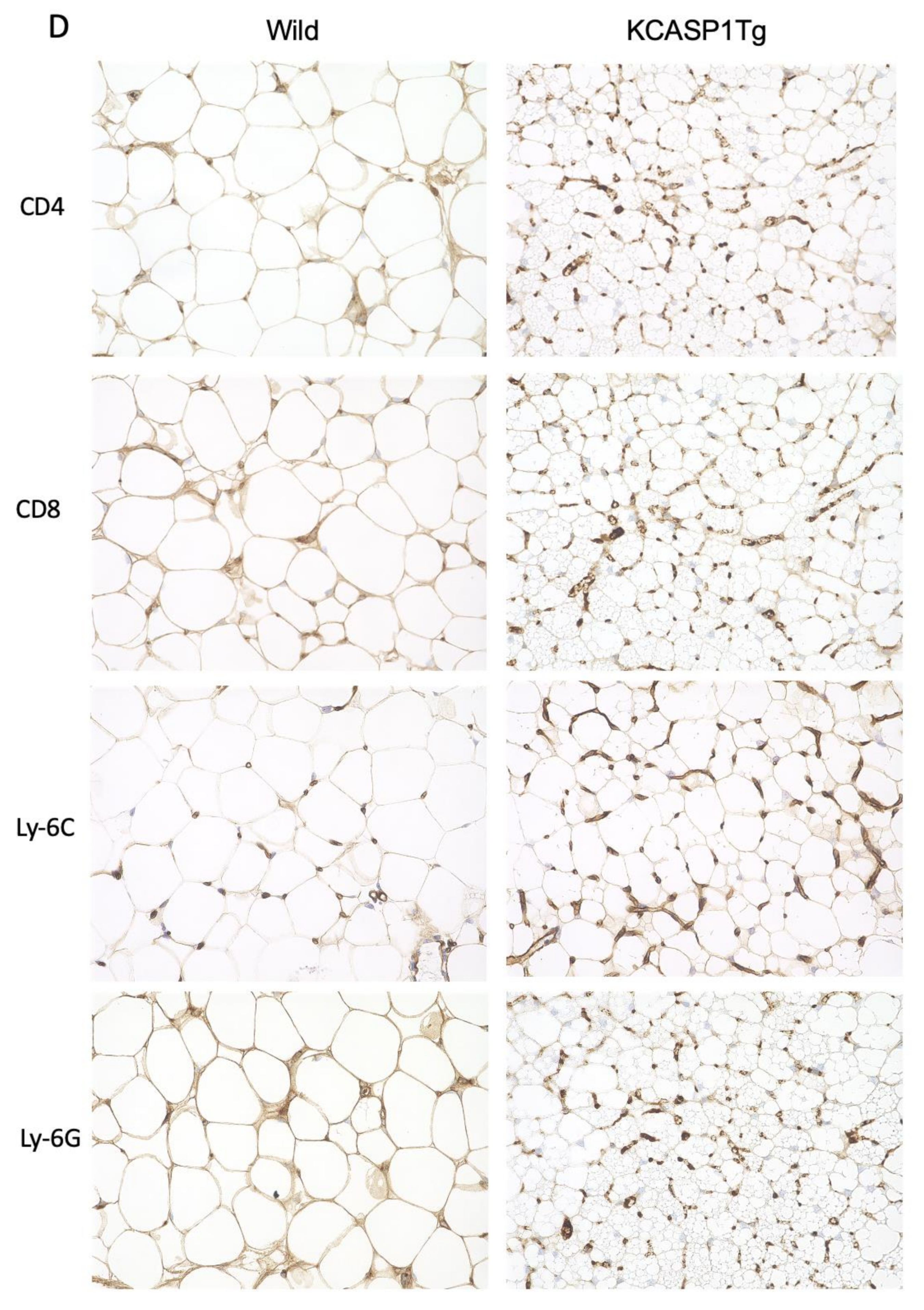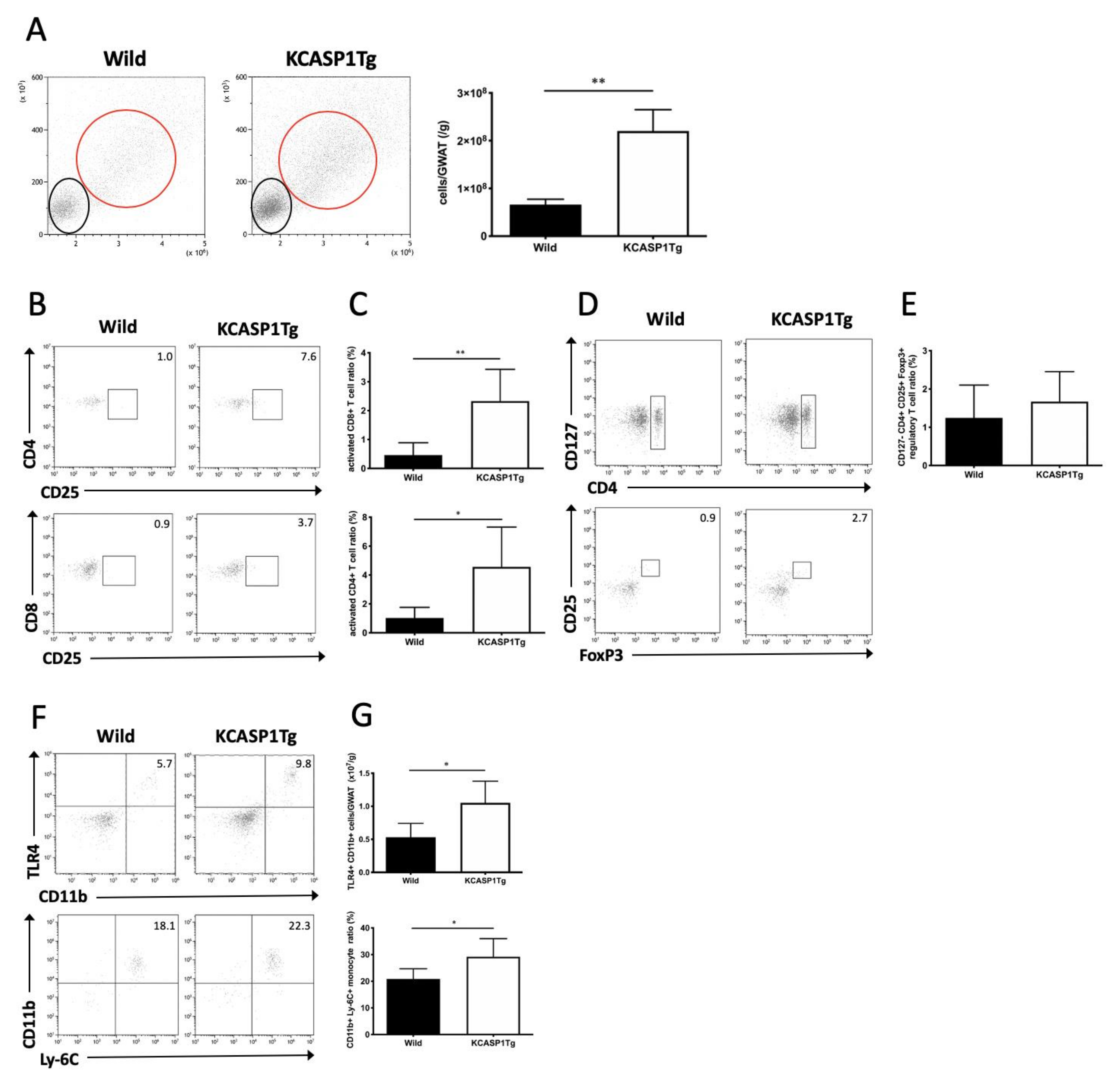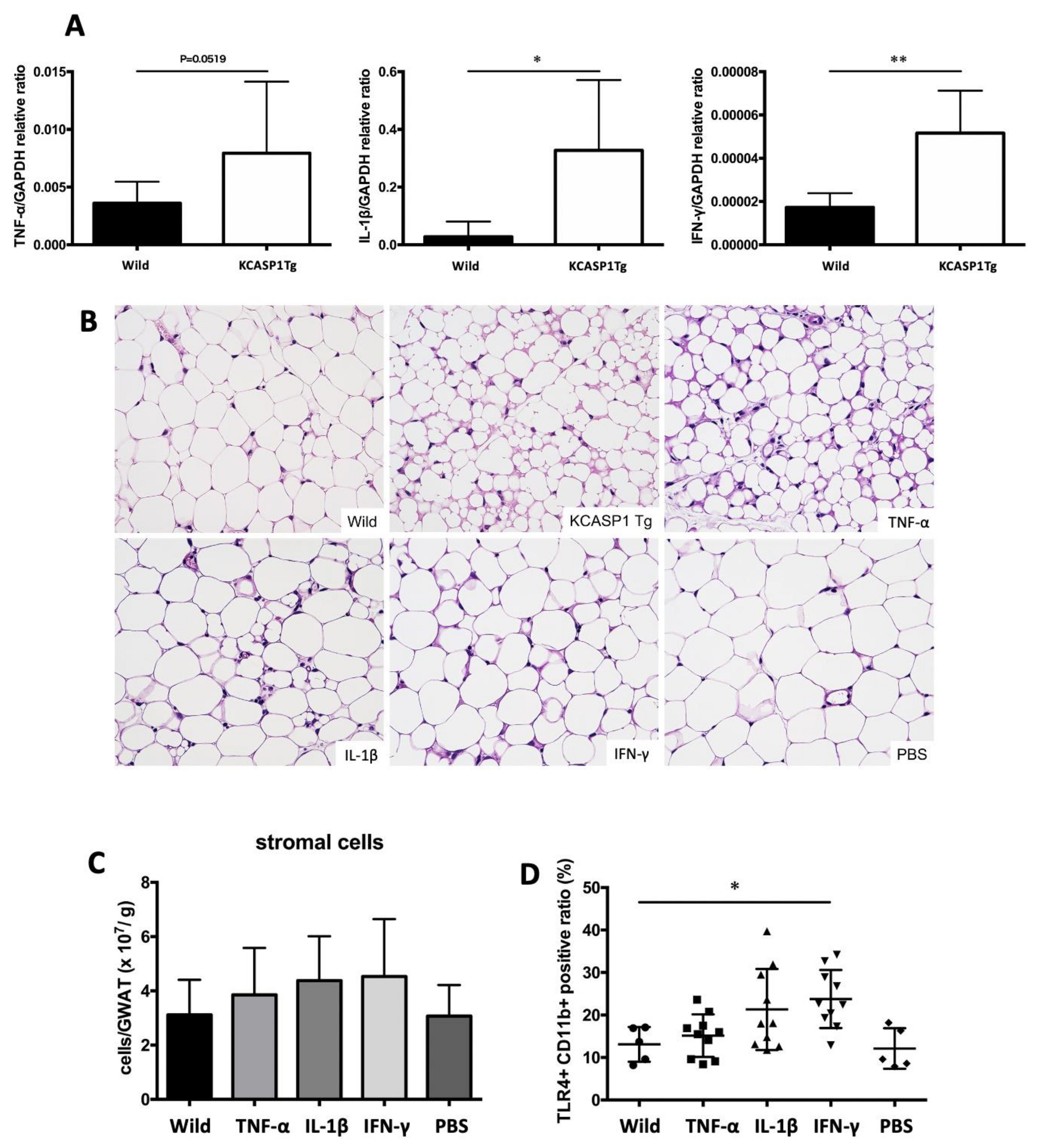Systemic Dermatitis Model Mice Exhibit Atrophy of Visceral Adipose Tissue and Increase Stromal Cells via Skin-Derived Inflammatory Cytokines
Abstract
1. Introduction
2. Results
2.1. GWAT Weight Is Decreased, and Inflammation Affects AT Atrophy
2.2. Activated T Cells and Monocytes Infiltrated the AT
2.3. Expression of Inflammation-Related Cytokine Levels in AT
2.4. Changes in UCP1 Expression after Cold Exposure
2.5. Pro-Inflammatory Cytokines Produced in Response to Dermatitis Caused AT Atrophy and Increased Activated Monocyte Infiltration In Vivo
3. Discussion
4. Materials and Methods
4.1. Mouse Study
4.2. Tissue Sampling
4.3. Histological and Immunohistochemistry Analysis
4.4. Flow Cytometry Analysis
4.5. Real-Time Polymerase Chain Reaction (PCR)
4.6. Enzyme-Linked Immunosorbent Assay (ELISA)
4.7. Statistical Analysis
5. Conclusions
Author Contributions
Funding
Conflicts of Interest
Abbreviations
| AT | adipose tissue |
| BSA | bovine serum albumin |
| ELISA | enzyme-linked immunosorbent assay |
| KCASP1Tg | keratin 14-specific caspase-1 overexpressing transgenic mouse |
| GWAT | gonadal white adipose tissue |
| HSP90 | heat shock protein 90 |
| IL | interleukin |
| INF | interferon |
| MCP-1 | monocyte chemotactic protein-1 |
| PBS | phosphate-buffered saline |
| PCR | polymerase chain reaction |
| TLR | toll-like receptor |
| TNF | tumor necrosis factor |
| UCP | uncoupling protein 1 |
References
- Scherer, P.E. Adipose tissue: From lipid storage compartment to endocrine organ. Diabetes 2006, 55, 1537–1545. [Google Scholar] [CrossRef] [PubMed]
- Gerdes, S.; Rostami-Yazdi, M.; Mrowietz, U. Adipokines and psoriasis. Exp. Dermatol. 2011, 20, 81–87. [Google Scholar] [CrossRef] [PubMed]
- Blaton, V. How is the metabolic syndrome related to the dyslipidemia? EJIFCC 2007, 18, 15–22. [Google Scholar] [CrossRef]
- Suganami, T.; Ogawa, Y. Adipose tissue macrophages: Their role in adipose tissue remodeling. J. Leukoc. Biol. 2010, 88, 33–39. [Google Scholar] [CrossRef] [PubMed]
- Caton, P.W.; Evans, E.A.; Philpott, M.P.; Hannen, R.F. Can the skin make you fat? A role for the skin in regulating adipose tissue function and whole-body glucose and lipid homeostasis. Curr. Opin. Pharmacol. 2017, 37, 59–64. [Google Scholar] [CrossRef] [PubMed]
- Coimbra, S.; Catarino, C.; Santos-Silva, A. The triad psoriasis-obesity-adipokine profile. J. Eur. Acad. Dermatol. Venereol. 2016, 30, 1876–1885. [Google Scholar] [CrossRef] [PubMed]
- Nakamizo, S.; Honda, T.; Adachi, A.; Nagatake, T.; Kunisawa, J.; Kitoh, A.; Otsuka, A.; Dainichi, T.; Nomura, T.; Ginhoux, F.; et al. High fat diet exacerbates murine psoriatic dermatitis by increasing the number of IL-17-producing gammadelta T cells. Sci. Rep. 2017, 7, 14076. [Google Scholar] [CrossRef] [PubMed]
- Yamanaka, K.; Tanaka, M.; Tsutsui, H.; Kupper, T.S.; Asahi, K.; Okamura, H.; Nakanishi, K.; Suzuki, M.; Kayagaki, N.; Black, R.A.; et al. Skin-specific caspase-1-transgenic mice show cutaneous apoptosis and pre-endotoxin shock condition with a high serum level of IL-18. J. Immunol. 2000, 165, 997–1003. [Google Scholar] [CrossRef]
- Black, R.A.; Kronheim, S.R.; Cantrell, M.; Deeley, M.C.; March, C.J.; Prickett, K.S.; Wignall, J.; Conlon, P.J.; Cosman, D.; Hopp, T.P.; et al. Generation of biologically active interleukin-1 beta by proteolytic cleavage of the inactive precursor. J. Biol. Chem. 1988, 263, 9437–9442. [Google Scholar]
- Yamanaka, K.; Nakanishi, T.; Saito, H.; Maruyama, J.; Isoda, K.; Yokochi, A.; Imanaka-Yoshida, K.; Tsuda, K.; Kakeda, M.; Okamoto, R.; et al. Persistent release of IL-1s from skin is associated with systemic cardio-vascular disease, emaciation and systemic amyloidosis: The potential of anti-IL-1 therapy for systemic inflammatory diseases. PLoS ONE 2014, 9, e104479. [Google Scholar] [CrossRef]
- Herrero, L.; Shapiro, H.; Nayer, A.; Lee, J.; Shoelson, S.E. Inflammation and adipose tissue macrophages in lipodystrophic mice. Proc. Natl. Acad. Sci. USA 2010, 107, 240–245. [Google Scholar] [CrossRef] [PubMed]
- Yamanaka, K.; Okada, K.; Nakanishi, T.; Mizutani, K.; Matsushima, Y.; Kondo, M.; Habe, K.; Mizutani, H.; Seo, N. Skin inflammation leads immunoglobulin G aggregation and deposition in multiple organs. J. Dermatol. Sci. 2017, 88, 146–148. [Google Scholar] [CrossRef] [PubMed]
- Leenen, P.J.; de Bruijn, M.F.; Voerman, J.S.; Campbell, P.A.; van Ewijk, W. Markers of mouse macrophage development detected by monoclonal antibodies. J. Immunol. Methods 1994, 174, 5–19. [Google Scholar] [CrossRef]
- Guzzo, C.; Ayer, A.; Basta, S.; Banfield, B.W.; Gee, K. IL-27 enhances LPS-induced proinflammatory cytokine production via upregulation of TLR4 expression and signaling in human monocytes. J. Immunol. 2012, 188, 864–873. [Google Scholar] [CrossRef]
- Schwartz, M.W.; Woods, S.C.; Porte, D.; Seeley, R.J.; Baskin, D.G. Central nervous system control of food intake. Nature 2000, 404, 661–671. [Google Scholar] [CrossRef]
- Nakajima, H.; Nakajima, K.; Tarutani, M.; Morishige, R.; Sano, S. Kinetics of circulating Th17 cytokines and adipokines in psoriasis patients. Arch. Dermatol. Res. 2011, 303, 451–455. [Google Scholar] [CrossRef][Green Version]
- Ommen, P.; Stjernholm, T.; Kragstrup, T.; Raaby, L.; Johansen, C.; Stenderup, K.; Iversen, L.; Rosada, C. The role of leptin in psoriasis comprises a proinflammatory response by the dermal fibroblast. Br. J. Dermatol. 2016, 174, 187–190. [Google Scholar] [CrossRef]
- Shibata, S.; Tada, Y.; Hau, C.S.; Mitsui, A.; Kamata, M.; Asano, Y.; Sugaya, M.; Kadono, T.; Masamoto, Y.; Kurokawa, M.; et al. Adiponectin regulates psoriasiform skin inflammation by suppressing IL-17 production from gammadelta-T cells. Nat. Commun. 2015, 6, 7687. [Google Scholar] [CrossRef]
- Yu, A.P.; Tang, J.; Xie, J.; Wu, E.Q.; Gupta, S.R.; Bao, Y.; Mulani, P.M. Economic burden of psoriasis compared to the general population and stratified by disease severity. Curr. Med. Res. Opin. 2009, 25, 2429–2438. [Google Scholar] [CrossRef]
- Budu-Aggrey, A.; Brumpton, B.; Tyrrell, J.; Watkins, S.; Modalsli, E.H.; Celis-Morales, C.; Ferguson, L.D.; Vie, G.Å.; Palmer, T.; Fritsche, L.G.; et al. Evidence of a causal relationship between body mass index and psoriasis: A mendelian randomization study. PLoS Med. 2019, 16, e1002739. [Google Scholar] [CrossRef]
- Wu, M.-Y.; Yu, C.-L.; Yang, S.-J.; Chi, C.-C. Change in body weight and body mass index in psoriasis patients receiving biologics: A systematic review and network meta-analysis. J. Am. Acad. Dermatol. 2020, 82, 101–109. [Google Scholar] [CrossRef] [PubMed]
- Matz, J.M.; Blake, M.J.; Tatelman, H.M.; Lavoi, K.P.; Holbrook, N.J. Characterization and regulation of cold-induced heat shock protein expression in mouse brown adipose tissue. Am. J. Physiol. Regul. Integr. Comp. Physiol. 1995, 269, R38–R47. [Google Scholar] [CrossRef] [PubMed]
- Nedergaard, J.; Cannon, B. Brown adipose tissue as a heat-producing thermoeffector. Handb. Clin. Neurol. 2018, 156, 137–152. [Google Scholar] [CrossRef] [PubMed]
- Wong, W. A signal to warm up to. Sci. Signal. 2016, 9, ec190. [Google Scholar] [CrossRef]
- Mathis, D. IL-33, imprimatur of adipocyte thermogenesis. Cell 2016, 166, 794–795. [Google Scholar] [CrossRef] [PubMed]
- Kato, S.; Matsushima, Y.; Mizutani, K.; Kawakita, F.; Fujimoto, M.; Okada, K.; Kondo, M.; Habe, K.; Suzuki, H.; Mizutani, H.; et al. The stenosis of cerebral arteries and impaired brain glucose uptake by long-lasting inflammatory cytokine release from dermatitis is rescued by Anti-IL-1 therapy. J. Investig. Dermatol. 2018, 138, 2280–2283. [Google Scholar] [CrossRef]
- Tatu, A.L.; Ionescu, M.A.; Clatici, V.G.; Cristea, V.C. Bacillus cereus strain isolated from Demodex folliculorum in patients with topical steroid-induced rosaceiform facial dermatitis. Bras. Dermatol. 2016, 91, 676–678. [Google Scholar] [CrossRef]
- Meena, S.; Gupta, L.K.; Khare, A.K.; Balai, M.; Mittal, A.; Mehta, S.; Bhatri, G. Topical corticosteroids abuse: A clinical study of cutaneous adverse effects. Indian J. Dermatol. 2017, 62, 675. [Google Scholar] [CrossRef]
- Orr, J.S.; Kennedy, A.J.; Hasty, A.H. Isolation of adipose tissue immune cells. J. Vis. Exp. 2013. [Google Scholar] [CrossRef]
- Lumeng, C.N.; Deyoung, S.M.; Bodzin, J.L.; Saltiel, A.R. Increased inflammatory properties of adipose tissue macrophages recruited during diet-induced obesity. Diabetes 2007, 56, 16–23. [Google Scholar] [CrossRef]






© 2020 by the authors. Licensee MDPI, Basel, Switzerland. This article is an open access article distributed under the terms and conditions of the Creative Commons Attribution (CC BY) license (http://creativecommons.org/licenses/by/4.0/).
Share and Cite
Mizutani, K.; Shirakami, E.; Ichishi, M.; Matsushima, Y.; Umaoka, A.; Okada, K.; Yamaguchi, Y.; Watanabe, M.; Morita, E.; Yamanaka, K. Systemic Dermatitis Model Mice Exhibit Atrophy of Visceral Adipose Tissue and Increase Stromal Cells via Skin-Derived Inflammatory Cytokines. Int. J. Mol. Sci. 2020, 21, 3367. https://doi.org/10.3390/ijms21093367
Mizutani K, Shirakami E, Ichishi M, Matsushima Y, Umaoka A, Okada K, Yamaguchi Y, Watanabe M, Morita E, Yamanaka K. Systemic Dermatitis Model Mice Exhibit Atrophy of Visceral Adipose Tissue and Increase Stromal Cells via Skin-Derived Inflammatory Cytokines. International Journal of Molecular Sciences. 2020; 21(9):3367. https://doi.org/10.3390/ijms21093367
Chicago/Turabian StyleMizutani, Kento, Eri Shirakami, Masako Ichishi, Yoshiaki Matsushima, Ai Umaoka, Karin Okada, Yukie Yamaguchi, Masatoshi Watanabe, Eishin Morita, and Keiichi Yamanaka. 2020. "Systemic Dermatitis Model Mice Exhibit Atrophy of Visceral Adipose Tissue and Increase Stromal Cells via Skin-Derived Inflammatory Cytokines" International Journal of Molecular Sciences 21, no. 9: 3367. https://doi.org/10.3390/ijms21093367
APA StyleMizutani, K., Shirakami, E., Ichishi, M., Matsushima, Y., Umaoka, A., Okada, K., Yamaguchi, Y., Watanabe, M., Morita, E., & Yamanaka, K. (2020). Systemic Dermatitis Model Mice Exhibit Atrophy of Visceral Adipose Tissue and Increase Stromal Cells via Skin-Derived Inflammatory Cytokines. International Journal of Molecular Sciences, 21(9), 3367. https://doi.org/10.3390/ijms21093367





